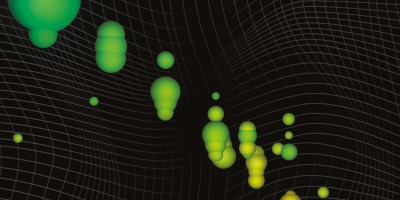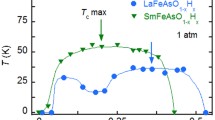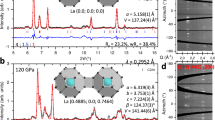Abstract
Recent experimental observations have showed some signatures of superconductivity close to 80 K in La3Ni2O7 under pressure and have raised the hope of achieving high-temperature superconductivity in bulk nickelates. However, a zero-resistance state—a key characteristic of a superconductor—was not observed. Here we show that the zero-resistance state does exist in single crystals of La3Ni2O7−δ using a liquid pressure medium at up to 30 GPa. We also find that the system remains metallic under applied pressures, suggesting the absence of a metal–insulator transition proximate to the superconductivity. Moreover, analysis of the normal state T-linear resistance reveals a link between this strange-metal behaviour and superconductivity. The association between strange-metal behaviour and high-temperature superconductivity is very much in line with other classes of unconventional superconductors, including the cuprates and Fe-based superconductors. Further investigations exploring the interplay of strange-metal behaviour and superconductivity, as well as possible competing electronic or structural phases, are essential to understand the mechanism of superconductivity in this system.




Similar content being viewed by others
Data availability
All data are available from the corresponding authors upon reasonable request. Source data are provided with this paper.
References
Norman, M. R. in Novel Superfluids, Vol. 2 (eds Bennemann, K.-H. & Ketterson, J. B.) Ch. 13 (Oxford Univ. Press, 2014).
Stewart, G. R. Unconventional superconductivity. Adv. Phys. 66, 75–196 (2017).
Bednorz, J. G. & Müller, K. A. Possible high Tc superconductivity in the Ba-La-Cu-O system. Eur. Phys. J. B 64, 189–193 (1986).
Chu, C. W. et al. Evidence for superconductivity above 40 K in the La-Ba-Cu-O compound system. Phys. Rev. Lett. 58, 405–407 (1987).
Kamihara, Y., Watanabe, T., Hirano, M. & Hosono, H. Iron-based layered superconductor La(O1−xFx)FeAs (x = 0.05-0.12) with Tc = 26 K. J. Am. Chem. Soc. 130, 3296–3297 (2008).
Chen, X. H. et al. Superconductivity at 43 K in SmFeAsO1−xFx. Nature 453, 761–762 (2008).
Sun, H. et al. Signatures of superconductivity near 80K in a nickelate under high pressure. Nature 621, 493–498 (2023).
Li, D. et al. Superconductivity in an infinite-layer nickelate. Nature 572, 624–627 (2019).
Zeng, S. et al. Phase diagram and superconducting dome of infinite-layer Nd1−xSrxNiO2 thin films. Phys. Rev. Lett. 125, 147003 (2020).
Osada, M., Wang, B. Y., Lee, K., Li, D. & Hwang, H. Y. Phase diagram of infinite layer praseodymium nickelate Pr1−xSrxNiO2 thin films. Phys. Rev. Mater. 4, 121801 (2020).
Zeng, S. et al. Superconductivity in infinite-layer nickelate La1−xCaxNiO2 thin films. Sci. Adv. 8, eabl9927 (2022).
Ding, X. et al. Critical role of hydrogen for superconductivity in nickelates. Nature 615, 50–55 (2023).
Wang, N. N. et al. Pressure-induced monotonic enhancement of Tc to over 30 K in superconducting Pr0.82Sr0.18NiO2 thin films. Nat. Commun. 13, 4367 (2022).
Li, Q. et al. Absence of superconductivity in bulk Nd1−xSrxNiO2. Commun. Mater. 1, 16 (2020).
Wang, B.-X. et al. Synthesis and characterization of bulk Nd1−xSrxNiO2 and Nd1−xSrxNiO3. Phys. Rev. Mater. 4, 084409 (2020).
Nakata, M., Ogura, D., Usui, H. & Kuroki, K. Finite-energy spin fluctuations as a pairing glue in systems with coexisting electron and hole bands. Phys. Rev. B 95, 214509 (2017).
Luo, Z., Hu, X., Wang, M., Wú, W. & Yao, D.-X. Bilayer two-orbital model of La3Ni2O7 under pressure. Phys. Rev. Lett. 131, 126001 (2023).
Zhang, Y., Lin, L.-F., Moreo, A. & Dagotto, E. Electronic structure, dimer physics, orbital-selective behavior, and magnetic tendencies in the bilayer nickelate superconductor La3Ni2O7 under pressure. Phys. Rev. B 108, L180510 (2023).
Gu, Y., Le, C., Yang, Z., Wu, X. & Hu, J. Effective model and pairing tendency in bilayer Ni-based superconductor La3Ni2O7. Preprint at https://doi.org/10.48550/ar**v.2306.07275 (2023).
Lechermann, F., Gondolf, J., Bötzel, S. & Eremin, I. M. Electronic correlations and superconducting instability in La3Ni2O7 under high pressure. Phys. Rev. B 108, L201121 (2023).
Yang, Q.-G., Wang, D. & Wang, Q.-H. Possible s±-wave superconductivity in La3Ni2O7. Phys. Rev. B 108, L140505 (2023).
Sakakibara, H., Kitamine, N., Ochi, M. & Kuroki, K. Possible high Tc superconductivity in La3Ni2O7 under high pressure through manifestation of a nearly half-filled bilayer hubbard model. Phys. Rev. Lett. 132, 106002 (2024).
Shen, Y., Qin, M. & Zhang, G.-M. Effective bi-layer model hamiltonian and density-matrix renormalization group study for the high-tc superconductivity in La3Ni2O7 under high pressure. Chin. Phys. Lett. 40, 127401 (2023).
Shilenko, D. A. & Leonov, I. V. Correlated electronic structure, orbital-selective behavior, and magnetic correlations in double-layer La3Ni2O7 under pressure. Phys. Rev. B 108, 125105 (2023).
Liu, Z. et al. Electronic correlations and energy gap in the bilayer nickelate La3Ni2O7. Preprint at https://doi.org/10.48550/ar**v.2307.02950 (2023).
Christiansson, V., Petocchi, F. & Werner, P. Correlated electronic structure of La3Ni2O7 under pressure. Phys. Rev. Lett. 131, 206501 (2023).
Cao, Y. & Yang, Y.-F. Flat bands promoted by Hund’s rule coupling in the candidate double-layer high-temperature superconductor La3Ni2O7 under high pressure. Phys. Rev. B 109, L081105 (2024).
Dong, Z. et al. Visualization of oxygen vacancies and self-doped ligand holes in La3Ni2O7−δ. Preprint at https://doi.org/10.48550/ar**v.2312.15727 (2023).
Liu, Z. et al. Evidence for charge and spin density waves in single crystals of La3Ni2O7 and La3Ni2O6. Sci. China Phys. Mech. Astron. 66, 217411 (2023).
Wu, G., Neumeier, J. J. & Hundley, M. F. Magnetic susceptibility, heat capacity, and pressure dependence of the electrical resistivity of La3Ni2O7 and La4Ni3O10. Phys. Rev. B 63, 245120 (2001).
Zhang, Z., Greenblatt, M. & Goodenough, J. Synthesis, structure, and properties of the layered perovskite La3Ni2O7−δ. J. Solid State Chem. 108, 402–409 (1994).
Taniguchi, S. et al. Transport, magnetic and thermal properties of La3Ni2O7−δ. J. Phys. Soc. Jpn 64, 1644–1650 (1995).
Ekin, J. W. et al. High Tc superconductor/noble-metal contacts with surface resistivities in the 10−10Ω cm2 range. Appl. Phys. Lett. 52, 1819–1821 (1988).
Blatter, G., Feigel’man, M. V., Geshkenbein, V. B., Larkin, A. I. & Vinokur, V. M. Vortices in high-temperature superconductors. Rev. Mod. Phys. 66, 1125–1388 (1994).
Jaroszynski, J. et al. Upper critical fields and thermally-activated transport of NdFeAsO0.7F0.3 single crystal. Phys. Rev. B 78, 174523 (2008).
Jiao, L. et al. Upper critical field and thermally activated flux flow in single-crystalline Tl0.58Rb0.42Fe1.72Se2. Phys. Rev. B 85, 064513 (2012).
Palstra, T. T. M., Batlogg, B., van Dover, R. B., Schneemeyer, L. F. & Waszczak, J. V. Dissipative flux motion in high-temperature superconductors. Phys. Rev. B 41, 6621–6632 (1990).
Ling, C. D., Argyriou, D. N., Wu, G. & Neumeier, J. Neutron diffraction study of La3Ni2O7: structural relationships among n = 1, 2, and 3 phases Lan+1NinO3n+1. J. Solid State Chem. 152, 517–525 (2000).
Sasaki, H. et al. Structural studies on the phase transition of La3Ni2O6.92 at about 550 K. J. Phys. Soc. Jpn 66, 1693–1697 (1997).
Fernandes, R. M., Chubukov, A. V. & Schmalian, J. What drives nematic order in iron-based superconductors? Nat. Phys. 10, 97–104, (2014).
Proust, C. & Taillefer, L. The remarkable underlying ground states of cuprate superconductors. Annu. Rev. Condens. Matter Phys. 10, 409–429 (2019).
Cooper, R. A. et al. Anomalous criticality in the electrical resistivity of La2−xSrxCuO4. Science 323, 603–607 (2009).
**, K., Butch, N. P., Kirshenbaum, K., Paglione, J. & Greene, R. L. Link between spin fluctuations and electron pairing in copper oxide superconductors. Nature 476, 73–75 (2011).
Taillefer, L. Scattering and pairing in cuprate superconductors. Annu. Rev. Condens. Matter Phys. 1, 51–70 (2010).
Licciardello, S. et al. Electrical resistivity across a nematic quantum critical point. Nature 567, 213–217 (2019).
Yuan, J. et al. Scaling of the strange-metal scattering in unconventional superconductors. Nature 602, 431–436 (2022).
Jiang, X. et al. Interplay between superconductivity and the strange-metal state in FeSe. Nat. Phys. 19, 365–371 (2023).
Greene, R. L., Mandal, P. R., Poniatowski, N. R. & Sarkar, T. The strange metal state of the electron-doped cuprates. Annu. Rev. Condens. Matter Phys. 11, 213–229 (2020).
Lee, K. et al. Linear-in-temperature resistivity for optimally superconducting (Nd,Sr)NiO2. Nature 619, 288–292 (2023).
Phillips, P. W., Hussey, N. E. & Abbamonte, P. Stranger than metals. Science 377, 169 (2022).
Hou, J. et al. Emergence of high-temperature superconducting phase in La3Ni2O7 crystals. Chin. Phys. Lett. 40, 117302 (2023).
Wang, G. et al. Pressure-induced superconductivity in polycrystalline La3Ni2O7−δ. Phys. Rev. X 14, 011040 (2024).
Eiling, A. & Schilling, J. S. Pressure and temperature dependence of electrical resistivity of Pb and Sn from 1-300 K and 0-10 GPa—use as continuous resistive pressure monitor AC curate over wide temperature range; superconductivity under pressure in Pb, Sn and In. J. Phys. F 11, 623 (1981).
Mao, H. K., Xu, J. & Bell, P. M. Calibration of the ruby pressure gauge to 800 kbar under quasi-hydrostatic conditions. J. Geophys. Res. Solid Earth 91, 4673 (1986).
Acknowledgements
We acknowledge fruitful discussions with C. Cao, H. Lin, F. Steglich and G. Zhang. We also thank S. Zhang and Y. Peng for sharing their unpublished single-crystal X-ray diffraction results, as well as Z. Dong, Y. Wang and Z. Chen for sharing their unpublished transmission electron microscopy results. Work at Zhejiang University was supported by the National Key R&D Program of China (grant nos. 2022YFA1402200 and 2023YFA1406100), the Key R&D Program of Zhejiang Province, China (grant no. 2021C01002), the National Natural Science Foundation of China (grant nos. 12034017, 12374151, 12174332, 12204408 and 12222410) and the Zhejiang Provincial Natural Science Foundation of China (grant no. LR22A040002). L.J. was supported by ‘the Fundamental Research Funds for the Central Universities’ (grant no. 226-2024-00039). Work at Sun Yat-sen University was supported by the National Natural Science Foundation of China (grant no. 12174454), Guangdong Basic and Applied Basic Research Funds (grant no. 2021B1515120015), Guangzhou Basic and Applied Basic Research Funds (grant no. 2024A04J6417) and Guangdong Provincial Key Laboratory of Magnetoelectric Physics and Devices (grant no. 2022B1212010008).
Author information
Authors and Affiliations
Contributions
H.Y. and L.J. conceived the experiments. The single crystals were provided by H.S., M.H. and M.W. Y.Z., D.S., Y.H., Z.S., K.Y., J.Z., Z.Y., Y.X., Y.S. and R.L. performed the transport, Laue, scanning electron microscope and energy-dispersive X-ray measurements. M.S., Y.Z., L.J. and H.Y. wrote the paper with input from all authors.
Corresponding authors
Ethics declarations
Competing interests
The authors declare no competing interests.
Peer review
Peer review information
Nature Physics thanks the anonymous reviewers for their contribution to the peer review of this work.
Additional information
Publisher’s note Springer Nature remains neutral with regard to jurisdictional claims in published maps and institutional affiliations.
Extended data
Extended Data Fig. 1 Resistance near the structural phase transition.
Resistance of La3Ni2O7−δ sample S1-1 at 13.7 GPa as a function of temperature from 280 K down to 2 K. The black (red) arrow denotes the data taken upon cooling (warming). At high temperatures there is both a weak anomaly and hysteresis between warming and cooling, which might be associated with a structural phase transition. Note that in Ref. 7 a change of room temperature crystal structure is observed above 10 GPa, and therefore this anomaly may correspond to a transition between the corresponding structural phases. The inset shows the sample configuration in the DAC after pressure loading. The resistance was measured using a four-probe method. The yellow and red arrows point to the gold electrode and the pressure-transmitting medium Daphne oil 7373, respectively. The black region in the middle is the sample, and the rubies and silver epoxy paste are underneath the sample.
Extended Data Fig. 2 R(T) curves at 16.6 GPa under different currents and I-V curves at different pressures and temperatures.
a, Resistance of sample S1-2 at 16.6 GPa in the vicinity of the superconducting transition, measured with different excitation currents. For currents below 31.6 μA, the resistance curve remains unaffected by the current magnitude. b, I-V curves of sample S1-2 at 1.5 K under various pressures. c, I-V curves of sample S1-2 at various temperatures under a pressure of 16.6 GPa. The critical current at 1.5 K is around 3 mA, and the sample has a cross-sectional area of 70 μm × 5 μm, allowing us to estimate a critical current density of 850 A/cm2.
Extended Data Fig. 3 Resistance of La3Ni2O7−δ single crystal samples under pressure.
We measured the R(T) curves of seven La3Ni2O7−δ single crystal samples under pressure. a-d, Four samples exhibited zero resistance at high pressures, and energy-dispersive x-ray analysis (EDX) measurements (Extended Data Fig. 4) show that three of these samples are more homogeneous and close to the stoichiometric composition (S1-1, S1-2, S1-3), while EDX of sample S2-1 was not measured as it broke upon releasing the pressure. For sample S1-3, in order to measure the Hall resistivity at high pressures (Extended Data Fig. 8), we used a 500-μm-diameter culet, which results in a more uneven pressure distribution near its maximum pressure of 20 GPa, leading to a broader superconducting transition at 18.9 GPa for this sample. e-g, The three samples (S2-2, S2-3, S2-4) with compositions far from 3:2:7 with large δ did not show zero resistance.
Extended Data Fig. 4 Scanning electron microscope images and chemical compositions of different La3Ni2O7−δ single crystal samples.
a-f, Scanning electron microscope (SEM) images were taken of six of the small samples that were measured in a DAC. For each sample, we used EDX to check the chemical composition. We randomly selected various positions (marked with blue solid dots) for chemical composition analysis, where the La content was normalized to 3. The final results are listed in the tables below the SEM images, where the mean values are also given, as well as the standard deviation in parentheses. On average, the atomic ratios of La:Ni:O for samples S1-1, S1-2, and S1-3 (a-c) are close to the stoichiometric values of 3:2:7, with smaller standard deviations indicating that those samples are more homogeneous. However, the atomic ratios of S2-2, S2-3, and S2-4 (d-f) deviate much more from stoichiometry, with larger variations in the compositions between different points across the sample. For S2-3, we also include a ‘selected average’ where the regions with Ni ≫ 2 are excluded from the statistics.
Extended Data Fig. 5 Possible origin of the extrinsic insulating behaviour.
We conducted measurements on samples S2 and S2-1 (panels a-b) which were subjected to thermal treatment (heated for 2 hours at 400 K) and sample S3 (panel c) which had no thermal treatment. After the thermal treatment, as shown in a and b, the R(T) curves (black left axis) at 1.2 GPa and 7.1 GPa both exhibit weakly insulating behaviour. However, it can be seen that the phase angle (red right axis) gradually deviates from zero with decreasing temperature, indicating that the measured resistance is not the intrinsic signal. At the same time, we found that the contact resistance between the silver epoxy paste and sample increased gradually from a few ohms at 300 K, to several tens of kiloohms at 2 K, which explains the sizeable deviation in the phase angle. In contrast, for the sample without heat treatment the contact resistance between the sample and silver epoxy paste remains at the level of ohms and does not change with temperature. As shown in c, as the temperature decreases the phase angle remains nearly zero, and the R(T) curve exhibits metallic behaviour. This suggests that the additional heat treatment may lead to oxygen vacancies, resulting in the formation of an insulating layer on the surface and an increase of the contact resistance upon cooling. This phenomenon has also been observed in Y1Ba2Cu3O7−δ33.
Extended Data Fig. 6 Temperature dependence of the upper critical fields at two pressures.
Upper critical field of sample S1-1 measured at a, 20.5 GPa, and b, 26.6 GPa. The red and black points in both panels represent the upper critical fields determined by \({T}_{c}^{\,{0}}\) and \({T}_{c}^{\tt{onset}}\), respectively, which are determined from the construction shown in Fig. 1. The solid lines show the results of fitting with a Ginzburg-Landau model, and the green region between red and black solid lines represents the region where there is an intermediate state or a thermally activated flux flow. By fitting Hc2(T) determined from \({T}_{c}^{\,{0}}\) with a Ginzburg-Landau model, we obtained Hc2(0) of 23 T and 19 T for 20.5 GPa and 26.6 GPa, respectively. By fitting Hc2(T) determined from \({T}_{c}^{\tt{onset}}\), respective zero-temperature values of 97 T and 83 T are obtained.
Extended Data Fig. 7 Crystal structure, Laue measurements, and magnetic susceptibility of single crystalline La3Ni2O7−δ.
a, Crystal structure. b, c, d, X-ray Laue pattern corresponding to the [001] direction, where simulations of the orthorhombic structure with space group Amam are shown by red spots. e, f, g Temperature dependence of the magnetic susceptibility χ(T) of samples S1-S3 measured in a magnetic field of 0.4 T applied perpendicular to the c axis. The temperature dependence of the magnetic susceptibility of the three samples are also displayed in this figure for fields perpendicular to the c-axis, which show similar behaviour, and also correspond well to the data in Ref. 29 for this field direction.
Extended Data Fig. 8 Hall resistivity ρxy (H) at 80 K under various pressures.
ρxy(H) for La3Ni2O7−δ sample S1-3 from 7.5 GPa to 19.4 GPa, where the red dashed lines show fits to a linear magnetic field dependence.
Source data
Source Data Fig. 1
Source data.
Source Data Fig. 2
Source data.
Source Data Fig. 3
Source data.
Source Data Fig. 4
Source data.
Source Data Extended Data Fig. 1
Source data.
Source Data Extended Data Fig. 2
Source data.
Source Data Extended Data Fig. 3
Source data.
Source Data Extended Data Fig. 4
Source data.
Source Data Extended Data Fig. 5
Source data.
Source Data Extended Data Fig. 6
Source data.
Source Data Extended Data Fig. 7
Source data.
Source Data Extended Data Fig. 8
Source data.
Rights and permissions
Springer Nature or its licensor (e.g. a society or other partner) holds exclusive rights to this article under a publishing agreement with the author(s) or other rightsholder(s); author self-archiving of the accepted manuscript version of this article is solely governed by the terms of such publishing agreement and applicable law.
About this article
Cite this article
Zhang, Y., Su, D., Huang, Y. et al. High-temperature superconductivity with zero resistance and strange-metal behaviour in La3Ni2O7−δ. Nat. Phys. (2024). https://doi.org/10.1038/s41567-024-02515-y
Received:
Accepted:
Published:
DOI: https://doi.org/10.1038/s41567-024-02515-y
- Springer Nature Limited





